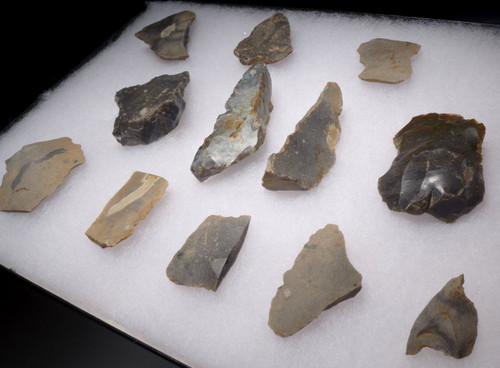Product Description
SEE MORE EUROPEAN NEOLITHIC ARTIFACTS
This is one of the RAREST Neolithic European stone artifacts you will ever see for sale. It is a genuine flint Neolithic END SCRAPER from one of the world's most famous, mysterious and important sites to Neolithic history - the Avebury Henge in England. Now a protected World Heritage Site, the Avebury Henge is THE LARGEST megalithic site in ALL of Europe! Since the site is protected, collecting there has and is strictly forbidden since 1965. This remarkable specimen comes from an old British private collection where this piece was gifted to the former owner in the 1950's, by famous Scottish archaeologist, Alexander Keiller who is famous for his extensive excavation work at Avebury starting in the 1930's. A museum dedicated to his work is at the site today and exhibits artifacts like this, which were found at the site.
Not only is this RARE Neolithic artifact from an extraordinary historic site, its provenance is of scientific celebrity status. This flake flint scraper tool possesses a white patina from hydration during long-term burial. Ancient sediment deposits are intact in all hinge fractures and micro-crevices of this specimen - irrefutable evidence of age and authenticity. Furthermore, ALL flint tools found at the Avebury site has this white patina so be suspect if you see flint tools offered with fraudulent claims of being excavated from Avebury, that show patinas with any color other than this white hue. More tools found on the site can be seen on this page when you scroll down.
HISTORY
The stone ring site at Avebury dates back to around 2600 BC and is Europe's largest Neolithic henge. Avebury is one of the best known prehistoric sites in Britain and even today amongst contemporary pagans, it holds great religious significance, as well as being a major historical tourist attraction. Its original purpose still a mystery, the site comprises three massive circles of stones believed to be a site of prehistoric ceremony. Avebury dwarfs the more famous Stonehenge and is frankly, much more significant as Avebury was part of a larger prehistoric complex, incorporating several other nearby monuments in West Kennet Long Barrow and Silbury Hill.
During the medieval period, many of the stones were toppled and buried, at the instigation of Christian clerics who believed it to be associated with the Devil; in later years some of the stones were broken up 'with fire and hammers' for building material. It attracted attention from early antiquarians such as John Aubrey (who made a plan of it) and William Stukely (who wrote of it); Charles II visited the site with Aubrey in 1663. Sir John Lubbock (1834-1913), 1st Baron Avebury who coined the terms 'Palaeolithic' and 'Neolithic' and authored early books on ancient man, purchased the site in 1871 to protect it. In 1934 the archaeologist Alexander Keiller (1889-1955) started excavations in the area and, recognizing its importance, he purchased the site and excavated the monument from 1937-1939 (report published 1965), forming a museum of the finds from 1938 and reinstating many of the buried stones as they were discovered. His work ceased with the start of the Second World War when the museum was closed; he sold the site to the National Trust in 1943 and, in 1966, his widow donated his museum contents to the nation; these are now displayed with other finds from the site which, with nearby Stonehenge, is now listed as a UNESCO World Heritage Site.


 US DOLLAR
US DOLLAR
 EURO
EURO
 AUSTRALIAN DOLLAR
AUSTRALIAN DOLLAR
 CANADIAN DOLLAR
CANADIAN DOLLAR
 POUND STERLING
POUND STERLING






















